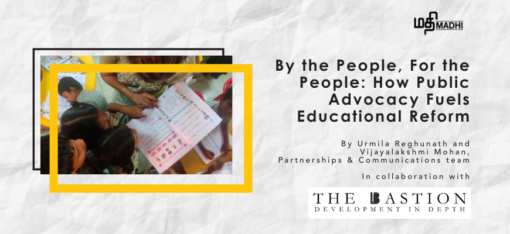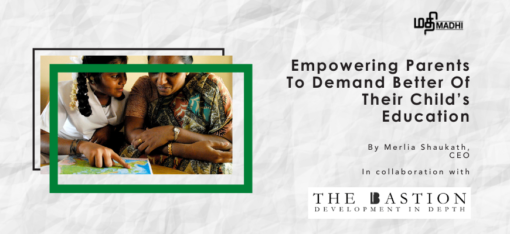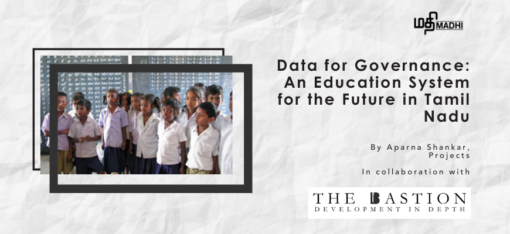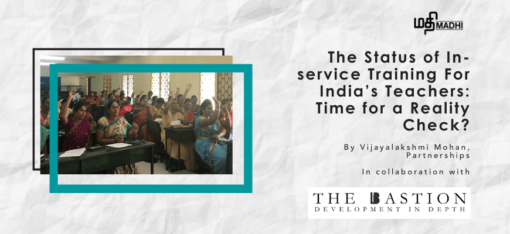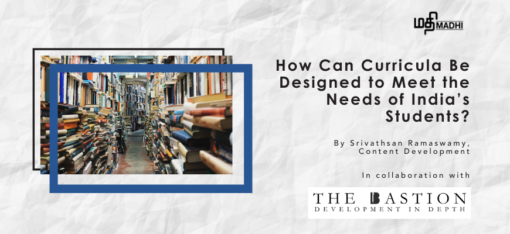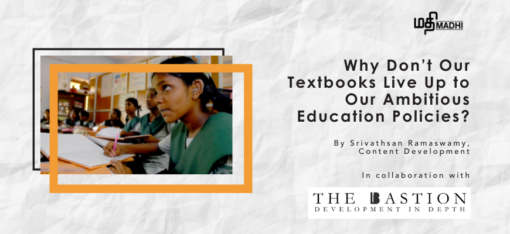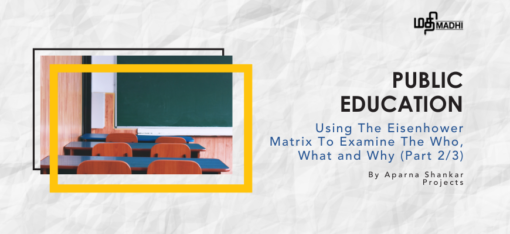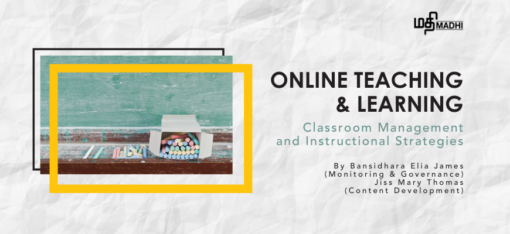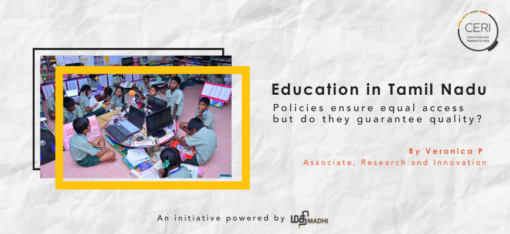
Education in Tamil Nadu – Policies ensure equal access but do they guarantee quality?
Education enables people to enhance their capability and functioning to lead a life of dignity. Tamil Nadu has focused on this crucial human development indicator since the formation of the Justice Party (political party established in 1916, in Madras presidency led by Natesa Mudaliar, which was succeeded by Dravidar Kazhagam). Post independence, consecutive governments have made Tamil Nadu one of the leading states in Human Resource Development. For instance, the Gross Enrolment Ratio (GER) in higher education is 51.4% (All India Survey on Higher Education 2019-20) which is almost double the national average. Tamil Nadu performs well in many educational indicators, such as literacy rate, gross enrolment of girls in higher education, and gross enrolment in middle school. The state also leads the protests against standardisation of exams, for instance Tamil Nadu has vehemently opposed the National Eligibility cum Entrance Test ( NEET) for admission into medical colleges and seeks exemption. Tamil Nadu takes a similar stance with respect to other educational policies which tend to commodify education.
Given this backdrop, an important question arises, why has Tamil Nadu consistently prioritised continuous innovations and reforms in the educational system, and uphold the educational aspirations of every community?
What made the difference?
Right to education is enshrined in the Dravidian ideology which emphasises education as a catalyst for social justice and equality. Ever since the formation of the Justice Party ‘education for all’ was the constant demand placed before the Madras Presidency (British colonial administrative unit comprising present day Tamil Nadu, Andhra Pradesh, some parts of Kerala, Karnataka, Odisha, and the Union Territory of Lakshadweep). In the 1930s compulsory primary education became a component of the fourteen point programme which E.V. Ramasamy (Periyar) drafted for the Justice Party. In their influential book, The Dravidian Model, published earlier this year, Vijayabaskar and Kalyanarasan observe that the Justice Party regarded education as a mode to access power. Periyar even laid a persuasive basis for democratisation of power through educational mobility. It is this vision of Periyar, one that has been channelled by subsequent Dravidian parties, which has contributed to consistent development in the education system.
Access to education as a means to claim self-respect was critical in reforming the educational system and broadening its scope to include all classes. Post-independence, when the parties of the left identified land reforms as a need for social justice, Dravidian parties pegged it on education. Land reform movement failed to redistribute resources. However, the Dravidian effort to utilise education as a means to obtain social justice proved to be a success. Evidence for this can be seen in literacy rates for Scheduled Castes and Scheduled Tribes, which in Tamil Nadu is 77% as against the national average of 70% (NSSO- Periodic Labour Force Survey 2017- 2018). Continuous institutionalised interventions and innovations in affirmative action by successive governments in the state helped in generating the notion of perceiving reservation policies as a rightful entitlement among the oppressed castes unlike in other parts of the
country.
Education and nutrition take centre stage
A groundbreaking idea envisaged by the Tamil Nadu government which helped to increase school enrolment rates was the mid-day meal scheme, mooted by the Justice Party. This was the beginning of the coupling of two social endeavours, nutrition and education, in a bid to improve the overall development indicators of its citizens. This proved to be an admirable strategy, lauded by many. In 1956, when Chief Minister of Tamil Nadu K Kamaraj reintroduced the mid-day meal scheme, the erstwhile moderate enrolment increased by 10% in primary level and 7% in the case of enrolment of girl children. Two years later, the attendance in schools increased by 33% in comparison to records of previous years. K. Kamaraj learnt that poverty denied not only education, but also nutritious regular meals to children. Serious implementation of the mid-day meals scheme which were resisted in the beginning, has now become a sought- after programme across the country. While Balwadis and Anganwadis were the target at the initial stage, in Tamil Nadu the scheme was extended to primary, middle, high, and higher secondary schools in stages. A scheme which was introduced merely as a magnet to pull children into the school system, has helped Tamil Nadu fare better in other educational parameters as well. More recently, the scheme has also been extended to include breakfast for all children in Tamil Nadu’s government schools by the incumbent DMK party in 2022.
Democratising education through affirmative action
Continuous improvements in affirmative action and democratisation strengthens the education system in Tamil Nadu. “Tamil Nadu does not subscribe to a very common Macaulayian fallacy – that there exists a strict linear relationship between examination rigour/performance and later career success. It ascribes to the view that the relationship is nonlinear and that strategic affirmative action could pay off as both short-term and long-term gains.” (Bharat Ram, 2017).
The state has constantly reworked the categories of reservations as a system of affirmative action to meet the changing demands of social justice (Kalaiyarasan & Vijayabaskar, 2021). This can be seen in multiple reforms by successive chief ministers. In 1989 a new category, ‘MBC’ (Most Backward Class) was created within the ‘BC’ (Backward Class) category to ensure that backward castes within the backward quota are given recognition. MBC were allotted 20% within the overall BC reservation of 20%. In 2007, the Karunanidhi led government provided a 3.5% quota each for Muslims and Christians with the OBC quota of 30%. In 2009, Tamilnadu Arunthathiyar Act was introduced to ensure representation of the Arunathathiyars by providing a 3% sub-quota within the 18% quota for Scheduled Castes(SC). Reservations thus not only became common sense but also an accepted means towards socio-economic mobility in Tamil Nadu (Pandian, 2007). All of these interventions in affirmative action have ensured better representation of marginalised groups and access to education.
Limits to growth
Although Tamil Nadu is ahead in many educational parameters when compared to the rest of the country, there has been limits to this growth. Tamil Nadu slipped a notch below in the Performance Grading Index (2020-21) with the scores on learning outcomes being stagnant at 132 (out of 180) since 2017-18. According to the ASER (Annual Status of Education Report) 2018 report, only 10% of students in Std 3 could read a Std 2 level text, and only 26% in Std 3 could do subtraction. The National Achievement Survey (NAS) 2021 highlights, 54% of students in Std 3 could not read and write numbers up to 999 using place value, 58% of students in Std 5 were not able to solve simple mathematical problems. Among Std 10 students only 8% had acquired intended learning outcomes in science and maths. Foundational Learning Study 2022 conducted by NCERT (National Council for Educational Research and Training) reveals that only 12 % of students in Tamil Nadu met global proficiency standards in literacy (Tamil) and only 20% met the global proficiency standards in numeracy. All these results are worrisome.
Research studies have proved that a child that lags behind in early childhood and the foundational stage stays behind at later levels. Learning crisis will act as negative externality in the growth trajectory of the state if left unattended.
Growing shift from public to private schools, mushrooming of engineering colleges with poor outcomes, and lack of continuous teacher training and development are a few other challenges that plague the education sector in Tamil Nadu today.
Hard reality
Once a state with literacy below average, because of poor attendance from economically weaker and socially backward communities, Tamil Nadu has attained a glorious rate of literacy through reformative thinking of leaders and successful implementations of student-centred programs. Despite easy access and availability of resources, there is a continued foundational literacy and numeracy crisis in the state. Even the reservation patterns and their effect on quality results remains untested.
After emphasising the significance of education and making it more accessible, the system is now challenged with improving student learning outcomes. Tamil Nadu needs to re-envision its educational framework to be aligned with the aspirations of society. The state has overcome several hurdles in reforming the education system. With a broader strategic framework focused on improving the quality of public education, Tamil Nadu can regain its position as front runner in the education sector.
Reference
Kalaiyarasan, A., & Vijayabaskar, M. (2021). The Dravidian model: Interpreting the political economy of Tamil Nadu. Cambridge University Press.
Pandian, M. S. S. (2007). Brahmin and non-Brahmin: Genealogies of the Tamil political present. Permanent Black.
Bharat Ram (2017) ,What is so neat about Tamil Nadu’s Education Strategy, ASER Report (2018) ,Annual Status of Education Report (Rural);
https://img.asercentre.org/docs/ASER%202018/Release%20Material/aserreport2018.pdf;
Foundational Learning Survey (2022), National report on benchmarking for oral reading fluency with reading comprehension and numeracy, https://dsel.education.gov.in/sites/default/files/FLS/National/National_Report_on_Benchmarking _for_ORF_and_Numeracy.pdf;
National Achievement Survey (2021),State report card Tamil Nadu, https://nas.gov.in/download-state-report/MzM=
Performance Grading Index (2020-21), Performance Grading Index for States and Union Territories, https://pgi.udiseplus.gov.in/PGI-State-2020-21-Brochure.pdf
Periodic Labour Force Survey (PLFS) 2017-2018, Annual report, https://cse.azimpremjiuniversity.edu.in/wp content/uploads/2019/02/Annual-Report-PLFS-2017-18_31052019.pdf;
This article was written under the aegis of the Centre for Education Research in India (CERI). CERI, an initiative powered by Madhi Foundation, is a digital repository and think-tank catering to policymakers, practitioners, and academics in the education sector and the larger community, to catalyse reform in the education ecosystem in India.
em {font-style: italic; font-size: 16px;}

